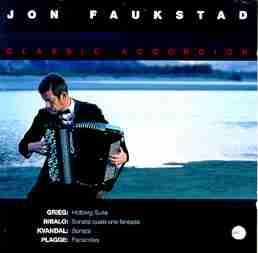
Program:
Edvard Grieg: Holberg Suite
total time: 46:78
label: Bergan Digital Studio
Order from:
Qualiton Imports, Ltd.
Jon Faukstad has been professor and Departmental head of the
Accordion division at the Norwegian Sate Academy of Music in Oslo since
1972. Taught by Mogens Ellegaard in the Royal Danish Conservatory of
Music, Faukstad became well versed in the literature for accordion and
developed a passion for Norwegian folk music of which he is considered an
authority and even published a book on the subject. As a consequence it
isn't surprising that most of the "classical" selections on this album
bear the imprint of Norwegian folk tradition.
Edvard Grieg is perhaps the most well known of Norway's classical
composers. His famous Holberg Suite of 1885 is usually performed
as a string orchestra piece though this arrangement was made from the
original piano score. The five short pieces modeled after the Baroque
dance suite display simple though inspired melodic lines which have been
perfectly adapted by Faukstad to fit the accordion's character. The
Prelude has lively arpeggiated figures which form a propulsive
rhythm over which a tender, brief descending sequence glides. A soft
hymn-like Sarabande follows while the Gavotte has a pleasant
easy going folk flavor. The fourth piece Air is the longest and
most serious of the suite. It's in a slow minor key reminiscent of Bach
perhaps because Ludvig Holberg, the playwright philosopher to whom the
work is dedicated, was a contemporary of Bach. A lively Rigoudon
dance concludes the suite.
The remainder of the disc is devoted to contemporary Norwegian
composers writing specifically for the free bass concert accordion. My
favorite work on this album (and the least folk music influenced) is
Antonio Bibalo's Sonata quasi un Fantasia which was written in 1978
and dedicated to Danish accordionist Mogens Ellegaard (Faukstad's
teacher). This one exhibits the exceptional organ-like power of the
chromatic free bass, often utilizing the extreme highs and lows of its
range. It is haunting and atmospheric with many well thought out
contrasts and subtle use of dynamics. It is in four sections which are
played without a break. A halting chordal beginning leads to a wild
allegro toccata followed by a somewhat menacing development section and
finishing with a nice surprising coda based on the allegro material.
Johan Kvandal begins his Sonata for Solo Accordion (1987)
with a slow dramatic melancholy Ballade in which the center section
drifts into a modal folk-like melody developed in fugal fashion. The
second movement has the character of a dance and is structured in rondo
form - the strict meter of the initial theme alternating with freer
sections.
The three Facsimiles for Accordion were written in 1992 by
Wolfgang Plagge. They make nice companion pieces to the Grieg suite as
they are made from simple diatonic melodies and could be called
neo-classical in structure. There is also humor here. The heavy regal
chords which punctuate the Marcato give way to playful scampering
lines and trills. The second tune Tranquillo is light and lilting
until underscored by deep bass in counterpoint which gives it a wistful
quality. The finale Allegro con brio presents a gleeful rambling
theme which returns several times at the end including one mock-serious
variation accented with bellow shakes.
Mr. Faukstad displays impressive artistry in his playing and
obviously loves what he's doing. The folk qualities of these pieces
should have initial appeal to many listeners and yet are complex enough
for repeated listening. Recording quality is quite good with noticeable
separation between bass and treble manuals (some might find that
distracting but I like it). The CD could have been longer though it's on
par with the older LP format.
CD booklet notes are written in Norwegian, English and French.
1. Prelude
Antonio Bibalo: Sonata quasi una fantasia
2. Sarabande
3. Gavotte
4. Air
5. Rigoudon
- Lentissimo
Johan Kvandal: Sonata for accordion solo
- Allegro molto
- Moderatamente me non rigido
- Allegro vivo
1. Ballade
Wolfgang Plagge: Facsimiles
2. Rondo
1. Marcato
2. Tranquillo
3. Allegro con brio
released: 1995
review date: December 1999
Norway Music
24-02 40th Avenue
Long Island City, NY 11101
USA
Tel.: 718-937-8515
Fax: 718 - 729-3239
Email:
qualiton@qualiton.com
| About The Free-Reed Review |
| Invitation to Contributors / Submission Guidelines |
| Back to The Free-Reed ReviewContents Page |
| Back to The Classical Free-Reed, Inc. Homepage |